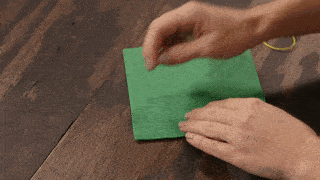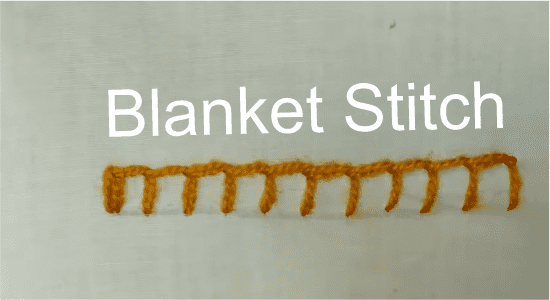Blanket stitch is a type of hand sewing that’s used to join two edges of fabric together. It can also be used to hem edges and create an embroidered border.
The stitch is usually made by putting the needle into the cloth part you’re joining at regular intervals, looping it over, and then pulling the thread through both layers of fabric. You’ll want to keep your stitches even with each other so the stitching will look nice and neat when you’re finished with it.
Blanket stitch is a common sewing technique used to attach pieces of fabric together without the use of seams. Instead, the fabric is sewn along its edges, with the nap (the direction in which fibers are stacked) facing outward to form a tube-like shape over time.
The softness and durability of blanket stitch make it popular for projects like baby bedding because it can be easily washed and can use high-quality fabrics that might be too delicate for other types of sewing. Generally, the blanket stitch is not intended to bind two pieces of fabric together; rather, blankets or quilts are typically made by sewing layers of different materials one on top of another.
You can use blanket stitches for more than sewing two edges together though, depending on how you use them. For example, blanket stitching can be used for attaching ribbons to a corsage or tassel. It can also be used as an embroidery stitch.
How to do Blanket Stitch?
This will step you through the process of blanket stitching. We will go through the process of what stitches to use, how to create them, and where they should fall in your project.

Prepare your materials:
Let’s begin by gathering your materials. What you’ll need is a textured fabric with an even nap (direction in which fibers are stacked), a long needle made for hand sewing, thread, and fabric tape or basting strap. You can also use plastic canvas instead of fabric if desired but it’s not quite as absorbent as woven cloth so it’s best for projects meant to be waterproof or outdoors-friendly like backpacks that may present water problems when washing.
Mount your fabric:
You can mount your fabric any way you see fit. Just make sure it’s taut and that the nap is clearly visible to you when looking at the cloth with the surface it will be sewn facing towards you. Position your blanket stitch on the wrong side of your fabric. The wrong side is where the fibers are folded to be on the inside of whatever you’re creating. If this side isn’t clear, use a loop turner or simply feel along until you find the point where it turns from smooth to textured on the surface of your material.
Create a foundation stitch:
In order for your blanket stitching to work, you’ll want to create a foundation stitch first. This will allow the stitches that follow it to be more obvious when they’re seen on the outside of your fabric. When you’re finished with one foundation stitch, go ahead and tack it down by placing thread through it with a needle in hand and pulling half of it tight. This will help secure your layers together and create a nice flat surface for you to continue stitching along.
Wrap the thread around:
Pull your needle through the back side of your fabric, behind where you just pulled the thread through. Then lay your fabric down on a flat surface and start wrapping that needle around in a circle, pulling it through twice before letting it go. When you do this, make sure to keep it even with each scalloped edge and with one another. This will also help keep all of your stitches straight.
Repeat this step until there are enough stitches to start creating form on the outside of your fabric. This can be anywhere between six to eight, depending on how many layers of fabric you’re working with and how much width you want to create at the end result.
When you’re finished, weave a needle through the back of the stitch when you pull it through. This will help secure it even further than usual so it doesn’t come loose.
Now that you know how to do a blanket stitch, create your project! You can use any kind of material for this if you like. It’s best for projects like backpacks or baby blankets that are meant for day-to-day use but can also be made into pillows, pictures, or other decorative materials if desired.
How to Crochet Blanket Stitch?
- First, you need to place two single crochet stitches together. Then, you will insert a new stitch between the two with an oval pattern. By doing this, one of the tops will be produced in an oval shape and when going over it again, it will produce a flap on the opposite side.
- Make a single crochet stitch on top of another adjacent stitch.
- Insert your hook into the space in-between them (the space is only one set of loops) and make a single crochet stitch that is as high as possible without making it go completely over your other stitches. Then, you can proceed to go back up with another regular single crochet until you have created one row that’s taller than the rest from top to bottom.
- Next, you need to go back up with another regular single crochet stitch by inserting your hook under the loops of the one from the other row that is closest to you. Then, you can begin making another row then make a single crochet stitch on top of each stitch/loop that is close to you.
- Continue the process until the last row is finished. By doing this, it will produce a crocheted pattern like an oval flap from side A to B and back again on side C since it will be facing inwards.
How to Crochet a Waffle Stitch Blanket?
The waffle stitch is a pattern used when crocheting in rounds and it is basically an interesting combination of many different crochet stitches. This pattern works especially well on textured surfaces while keeping the edges of your work looking beautiful and smooth without any bumps or lumps. This stitch can be used to create decorative borders on curtains, cushion covers, blankets, blankets for pets, and so much more.
Steps to Crochet a Waffle Stitch Blanket:
Here below are the steps to crochet a waffle stitch blanket.
- Step 1: Begin by crocheting two double crochet stitches together to make a foundation single crochet stitch.
- Step 2: Make two chain stitches and then put two double crochet stitches in the same space to make a single crochet.
- Step 3: Put one double crochet in the next chain stitch and then put one double crochet in each chain stitch until you reach the end.
- Step 4: Now you need to chain twice, turn your work and start making single crochets till you get to the final row.
- Step 5: Repeat these steps for every row and then continue on until your desired blanket size has been reached.
Tips for Working With Waffle Stitch Blankets:
If you have a round-hooked needle, your work will be easier to do since it passes through all of these loops with ease.
How to do corner blanket stitching?
The corner blanket stitch is made by inserting the needle under two stitches. The stitches should be facing away from you and you should have a single crochet stitch on top of the row below your take, in between these two stitches.
Insert the needle under a loop on the first bottom side, but do not grab it yet; this is what will give your work that smooth finish when you pull up through it and out through the top loop.
You should now insert the needle under a loop on the opposite side of where it came up from, then grab onto this stitch to finish off your corner blanket stitch. Cut your thread off and make sure that everything is secure and there are no loose ends. Then, it’s just a matter of going around the work until you get to the opposite corner and doing the same thing there.
Blanket Stitching Steps Wrap Up
- The Preparation
To prepare for blanket stitching, you will need to make a slip stitch on the bottom side of your work. This is done by crocheting into one of the lowest chains on your crochet pattern and then making one chain stitch. Then, place another single crochet in this newly made chain to finish off the first row. Afterward, you can begin working with every other row that has been previously completed and follow this process until you get to the final row where you will then start making a new round. After finishing that round, it’s just a matter of going around from corner to corner and sewing down any loose ends if needed.
- Stitching as a Line
With this method, you can keep your crochet stitches close to one another. This is especially helpful when working in rows because it will mean that you are getting closer and closer to the sides of your work regularly as you go around. After finishing each corner, it’s just a matter of doing the same thing from the first corner and then going from there.
- Going Around Shapes
This is one of the easiest ways to go around shapes. You need to start with the corner that is on each side of your shape and then go around in a line until you reach the final corner. Then, you need to finish off by making a slip stitch in this final loop and then crocheting two single crochet stitches together. This will help your work keep its shape because it will also be easier to sew down any loose ends if needed.
- Varying Stitch and Space Length
The way that you space out your stitches and gaps can have either a positive or a negative effect on your work. The best stitch to use when working with varying stitches is the single crochet stitch because it is simple and easy, comes together quickly and its shape is small, so it can be used for almost anything. This stitch also has an outstanding finish that helps to lessen some of the visible bumps on your work because they will decrease as they get closer to the other rows above them.
If you are adding spaces into your pattern, consider how long you want them to be.
Final Thoughts
This article is about blanket stitching, which can be an invaluable skill for crocheting. Blanket stitching is a way of sewing down any loose ends and ensuring that there are no loose ends. It also involves carrying on with your work around the shape of your design subject, like corners or angles. This is a trending business so expand your skills and business projects by using different patterns of blanket stitching. Go Ahead and explore this world for countless opportunities.

